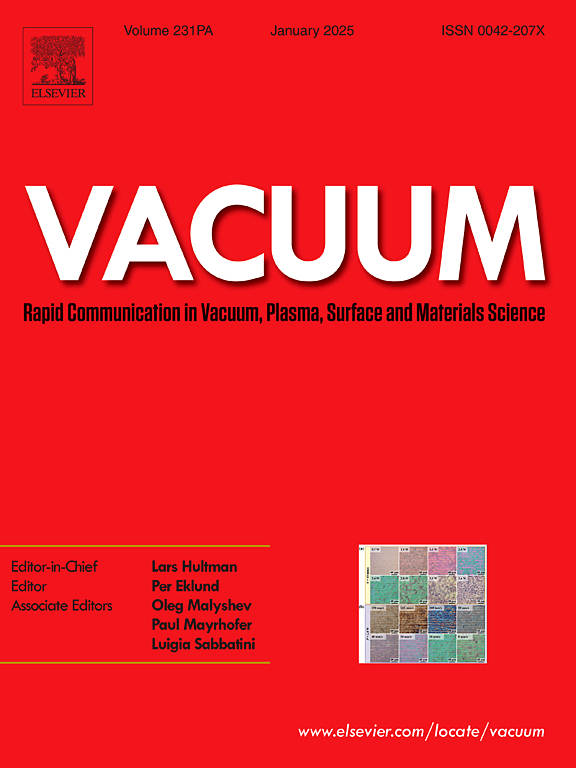从一个靶材通过脉冲激光沉积获得的 YBa2Cu3O7-δ 薄膜在厚度上的元素成分分布变化
IF 3.8
2区 材料科学
Q2 MATERIALS SCIENCE, MULTIDISCIPLINARY
引用次数: 0
摘要
通过脉冲激光沉积技术,在不同条件下(使用和不使用速度过滤技术)在 SrTiO3(100)基底上沉积了厚度分别为 150-200 nm 和 300 nm 的外延 YBa2Cu3O7-δ (YBCO) 薄膜。薄膜的 T(R = 0) 范围为 77.4-87 R(T),具体取决于从一个含有 YBa2Cu3O6.8 成分的靶上沉积的条件。薄膜含有从靶材中获得的 Zn、Sr、Pd、Ag 和 Ti 杂质元素(总含量不超过 2%)。薄膜电阻温度相关性数据、X 射线相分析、X 射线荧光 (XRF) 光谱分析以及用 SEM 方法对表面凹凸的研究表明,杂质和基体 Y、Ba、Cu 元素在薄膜深度上的分布不均匀。表面附近的杂质浓缩导致表面形成刻面螺旋金字塔,根据奥斯特瓦尔德机制,这些金字塔可能演变成大的拉长颗粒。这些知识对于优化脉冲激光沉积技术和制造用于研究物理现象的二维仪器和设备具有重要的现实意义。本文章由计算机程序翻译,如有差异,请以英文原文为准。
Variations of the elemental composition distribution over the thickness of YBa2Cu3O7-δ thin films obtained by pulsed laser deposition from one target
Epitaxial YBa2Cu3O7‒δ (YBCO) films 150–200 and 300 nm thick, respectively, were deposited on SrTiO3 (100) substrates by pulsed laser deposition at different conditions: with and without using the velocity filtration technique. The films have T(R = 0) in the range of 77.4–87 R(T) depending on the conditions of deposition from one target with YBa2Cu3O6.8 composition. The films contain Zn, Sr, Pd, Ag and Ti impurity elements obtained from the target (a total of no more than 2 at. %). Data of the film resistance temperature dependences, X-ray phase analysis, analysis of X-ray fluorescence (XRF) spectra and study of the surface relief by SEM methods revealed the nonuniform distributions of impurity and matrix Y, Ba, Cu elements over the film depth. Impurity concentrations near the surface lead to the formation of faceted spiral pyramids on the surface, which probably evolve into large elongated particles according to the Ostwald mechanism. This knowledge is practically important for optimizing pulsed laser deposition technologies and creating 2D instruments and devices for studying physical phenomena.
求助全文
通过发布文献求助,成功后即可免费获取论文全文。
去求助
来源期刊

Vacuum
工程技术-材料科学:综合
CiteScore
6.80
自引率
17.50%
发文量
0
审稿时长
34 days
期刊介绍:
Vacuum is an international rapid publications journal with a focus on short communication. All papers are peer-reviewed, with the review process for short communication geared towards very fast turnaround times. The journal also published full research papers, thematic issues and selected papers from leading conferences.
A report in Vacuum should represent a major advance in an area that involves a controlled environment at pressures of one atmosphere or below.
The scope of the journal includes:
1. Vacuum; original developments in vacuum pumping and instrumentation, vacuum measurement, vacuum gas dynamics, gas-surface interactions, surface treatment for UHV applications and low outgassing, vacuum melting, sintering, and vacuum metrology. Technology and solutions for large-scale facilities (e.g., particle accelerators and fusion devices). New instrumentation ( e.g., detectors and electron microscopes).
2. Plasma science; advances in PVD, CVD, plasma-assisted CVD, ion sources, deposition processes and analysis.
3. Surface science; surface engineering, surface chemistry, surface analysis, crystal growth, ion-surface interactions and etching, nanometer-scale processing, surface modification.
4. Materials science; novel functional or structural materials. Metals, ceramics, and polymers. Experiments, simulations, and modelling for understanding structure-property relationships. Thin films and coatings. Nanostructures and ion implantation.
 求助内容:
求助内容: 应助结果提醒方式:
应助结果提醒方式:


